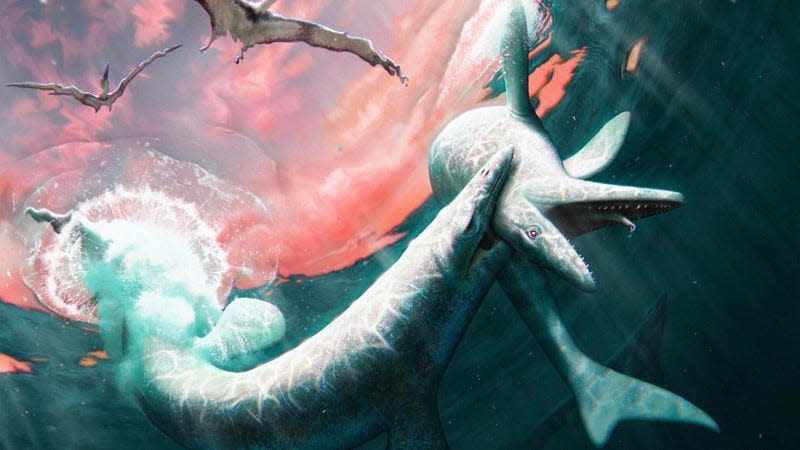Meet Jormungandr, a 'Sea Dragon' From North Dakota

No aquatic reptiles today can match mosasaurs, ocean-dwelling creatures of the Cretaceous period that looked something like a cross between a whale and a shark. Now, a group of researchers have discovered a mosasaur that they believe bridges the gap between two iconic species in the ancient group.
The newly described mosasaur is Jormungandr walhallaensis, a 24-foot-long 7.3-meter-long) lizard with sharp teeth and a stumpy tail that inhabited the Western Interior Seaway, a body of water hundreds of miles across that stretched from the Arctic to the Gulf of Mexico. The team’s research describing the find was published today by the American Museum of Natural History.
Read more
Switch 2 Could Look Like One Of Nintendo's Classic Handhelds
Car Enthusiasts In New Zealand Are Blaring Celine Dion Songs In 'Siren Battles'
Zoe Kravitz and Channing Tatum Are Reportedly Heading to the Chapel
“This fossil is coming from a geologic time in the United States that we don’t really understand,” said study co-author Clint Boyd, a paleontologist with the North Dakota Geological Survey, in the same release. “The more we can fill in the geographic and temporal timeline, the better we can understand these creatures.
According to the research team, Jormungandr shares features with Clidastes, a smaller mosasaur that inhabited the Western Interior Seaway farther south, in what is today Kansas, and Mosasaurus, a massive, 50-foot-long (15.2-meter-long) mosasaur that coexisted with Tyrannosaurus rex. The team believes that Jormungandr arrived on the Cretaceous scene before Mosasaurus. It is one of the northernmost mosasaurs found in the Western Interior Seaway, and expands the known range of the animals into Campanian North America, according to the team.
“As these animals evolved into these giant sea monsters, they were constantly making changes,” Zietlow said. “This work gets us one step closer to understanding how all these different forms are related to one another.”
Mosasaurs were a diverse group of predators. The term “mosasaur” was coined before “dinosaur,” and yet research is still catching up with all the eccentricities of the marine reptiles. In 2020, a team found evidence that mosasaurs laid eggs, and research presented last year at the Society of Vertebrate Paleontology’s annual meeting indicated that mosasaurs could open their jaws very wide, and may have been venomous. Earlier this year, a different team described a mosasaur species with teeth ridged like a Phillips head screwdriver, perhaps to crunch through shell or fish bones.
Jormungandr appears in the in-betweens of the known mosasaur record, giving researchers a helpful new branch on their family tree. With any luck, more mosasaurine finds will fill out the tree even more, clarifying the relationships of these ancient marine lizards.
More: Just When You Thought Mosasaurs Couldn’t Get Any Scarier
More from Gizmodo
America’s EV Adoption Is Still Stalling Over High Cost And Low Range
Tesla Fanatics Melt Down Over Model Y Owner Who Added Buttons To Touchscreen
34 Million People Have Played The Best Assassin’s Creed Ever
Sign up for Gizmodo's Newsletter. For the latest news, Facebook, Twitter and Instagram.

